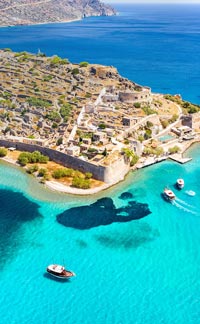This palace, found on Crete’s relatively short east coast, is one of the most recently excavated Minoan sites. It is a little south of another ancient Minoan settlement, Palaikastro. Zakros is the smallest of Crete’s 4 excavated palaces (the others are Malia, Phaistos, and Knossos). The extent of the palace is a bit larger than an acre (4,500 square meters) and was the focal point of a larger settlement. For comparison, the palace at Knossos, the capital of the ancient Minoan civilization, is 5 times larger than that at Zakros.
Zakros was likely the chief administrative, religious, population, and commercial center on Crete’s eastern shore. Situated on an ancient harbor from which the sea has retreated some 120 meters, Zakros traded with Cyprus, Egypt, and the Middle East. Objects originating from those places have been found there.
On-site excavations started in the early 20th century under British archeologist David George Hogarth, who was with the Athens-based British School of Archeology. After a period of inactivity, excavations resumed in the 1960s under well-known Greek archeologists Nikolaos Platon. Excavations at Zakros are ongoing.
The advantage of this being a recent excavation is that more modern methodologies are being used, which results in better preservation efforts. Zakros also stayed undiscovered for a long time, which means that it was never looted.
Zakros Palace is closed on Mondays, but open the other days of the week from 09:00-15:00. It’s reachable by bus from Sitia, and the 45 km journey takes about an hour.




















